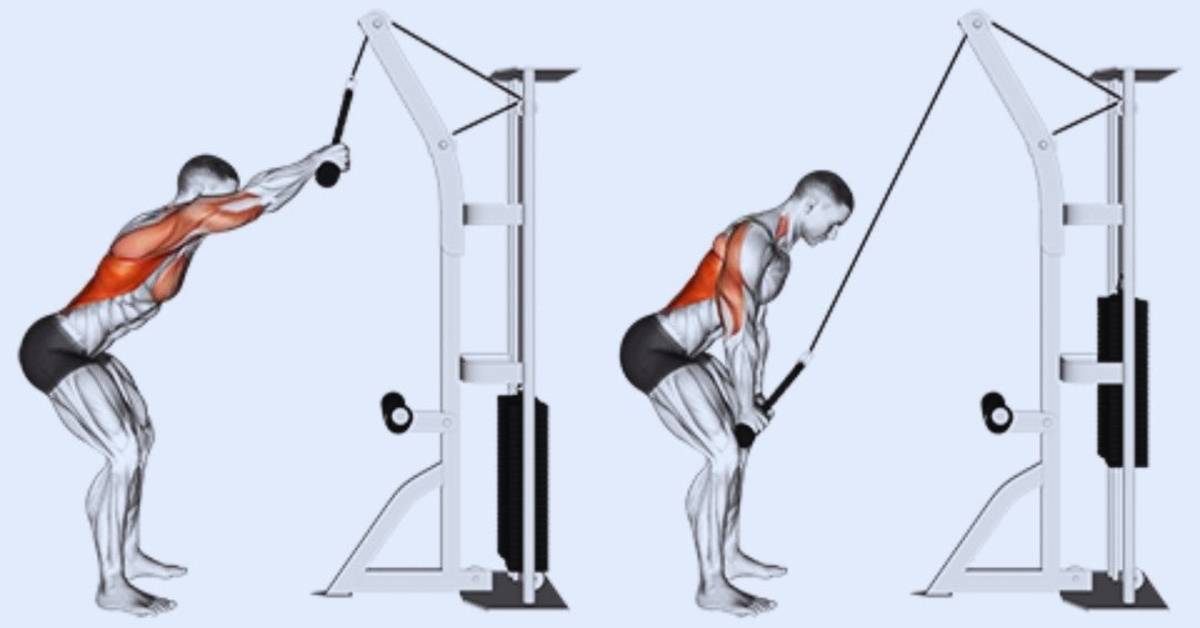The Tate Press exercise is an incredibly effective workout to help you increase tricep size Mainly it focuses on the medial head of the triceps. Are you looking for that toned and chiseled arms? It’s time to add the this exercise to your workout routine! This comprehensive guide will provide you with everything you need to know about performing Tate presses, including how it works, what muscles are targeted, variations of the move, and much more! Follow these steps carefully for a complete triceps Tate Press training program that will help get your dream arms in no time.
Muscles Worked During Dumbbell Tate Press Exercise
When performing DB Tate presses, you are specifically targeting the medial head of the tricep muscle. This muscle is responsible for elbow extension and joint stabilization in the arm. It can also help to tone and strengthen your shoulders since they work together to complete each repetition. In addition, Tate press Dumbbell can also hit the chest and some of the muscles located around the shoulder, such as the lower trapezius and serratus anterior.
How to Perform Tate Presses Step By Step.
1. Start off by sitting on a flat bench and grabbing two dumbbells. Make sure that your palms are facing each other, so that the dumbbells are resting right in front of your chest.
2. Take a deep breath and slowly extend your arms until they are straight.
3. Keep your elbows tucked in tightly to your body and slowly lower the dumbbells towards your chest until they are just above it.
4. Squeeze your triceps and press the weight back up to the starting position, making sure not to lock out your arms at the top of the movement.
5. Repeat the Tate press movement for the desired number of sets and reps. Rest in between sets to allow your muscles to recover properly.
Tips to get Maximum Results
1. Keep your back flat on the bench and your feet firmly planted on the ground. In this way, you will be able to maintain proper form and prevent injuries.
2. Keep your elbows close to your body as you lower and raise the dumbbells, as this will ensure that you are isolating the triceps muscles.
3. You should start with lighter weights until you get used to the motion, then gradually increase the weight as you become accustomed to it.
4. Focus on slow and controlled movements throughout each repetition rather than rushing through them.
5. Stretch your triceps before and after each workout to reduce soreness and improve flexibility.
6. Keep your head and neck neutral throughout the exercise to maintain proper form.
7. When lowering and raising the dumbbells, focus on breathing in as you lower and exhaling as you raise them back up to avoid stressing your core muscles.
Common Mistakes to Avoid While Performing Tate Press
People make several common mistakes while performing this exercise, which can lead to injury or reduce the effectiveness of the workout. The following are some of the most common mistakes to avoid:
Flaring the Elbows
When performing the exercise, keeping your elbows close to your body is important. If you flare your elbows outward, you can put unnecessary strain on your shoulders and reduce the effectiveness of the exercise.
Using too Much Weight
The Tate Press is an isolation exercise, which means it’s designed to target a specific muscle group. Using too much weight can cause you to use other muscles to compensate, which can lead to injury or reduce the effectiveness of the workout.
Not Keeping the Wrists Straight
It’s important to keep your wrists straight while performing the Tate Press to avoid putting unnecessary strain on your joints. This can also help you maintain proper form throughout the exercise.
Failing to Control the Weight
It is a slow and controlled exercise, and it’s important to maintain proper form throughout each repetition. Failing to control your weight can cause you to lose balance or drop weight, leading to injury.
Not Using a Proper Range of Motion
It’s important to use a full range of motion. This means lowering the weight to your chest and pressing it back up until your arms are fully extended. Failing to use a full range of motion can reduce the effectiveness of the exercise and limit your gains.
By avoiding these common mistakes and focusing on proper form and technique, you can get the most out of your Tate Press workouts and avoid injury.
Benefits of Dumbbell Tate Press Exercise
Here are some of the benefits of including the Dumbbell Tate Press in your workout routine:
Targets the Triceps Muscles
It is a highly effective exercise for targeting and isolating the triceps muscles. This can help to build strength and size in these muscles, which can improve overall upper-body strength and power.
Can Improve Bench Press Performance
It can also help to improve performance on the bench press. By strengthening the triceps, you can push more weight and generate more power during the pressing movement.
Can Improve Overall Upper Body Strength
The Tate Press can help to build overall upper body strength, as it targets a major muscle group in the upper body. This can translate into improved performance in other upper body exercises, such as shoulder presses, pull-ups, and rows.
Can Improve Muscle Definition
By targeting the triceps muscles, the Tate Press can help to improve muscle definition in the back of the upper arm. This can create a more aesthetically pleasing physique and enhance overall muscle tone.
Can be Performed with Minimal Equipment
It can be performed with minimal equipment, making it a great exercise for those who don’t have access to a gym or prefer to work out at home. You only need a set of dumbbells or a barbell to get started.
Alternatives and Variations of Tate Press
Like any exercise, mixing and incorporating variations is important to prevent plateaus and keep your workouts interesting. Here are some alternatives and variations of the Tate Press that you can add to your workout routine.
Close-Grip Bench Press
The Close-Grip Bench Press is an excellent alternative to the Tate Press, targeting the triceps muscles, chest, and shoulders. To perform this exercise,
1. Set up the bench: Set a flat bench in a squat rack or power cage. Adjust the rack height, so the bar is at chest level when lying on the bench.
2. Set up the bar: Load the appropriate weight onto the bar and then add collars to secure the weights. Lie on the bench with your feet flat on the floor.
3. Grip the bar: Grip the bar with your hands positioned shoulder-width apart, keeping your thumbs wrapped around the bar. Your palms should be facing toward your feet.
4. Unrack the bar: Unrack the bar by straightening your arms, lifting it off the rack, and holding it above your chest.
5. Lower the bar: Lower the bar towards your chest, keeping your elbows close to your body. Your elbows should be at a 45-degree angle to your torso.
6. Press the bar: Press the bar back up to the starting position by extending your arms fully. Make sure to exhale as you press the bar up.
Skull Crushers
Skull Crushers, also known as Lying Triceps Extensions, are another effective exercise for targeting the triceps muscles. To perform this exercise,
1. Set up the bench: Set a flat bench in a safe, open space. Place a barbell on the floor behind the bench.
2. Lie on the bench: Lie down on the bench with your head towards the end of the bench where your feet usually go. Keep your feet flat on the floor and your knees bent.
3. Pick up the barbell: Pick up the barbell with a grip slightly narrower than shoulder-width apart. Your palms should be facing up, and your elbows should be fully extended.
4. Hold the barbell above your chest: Hold the barbell with your arms fully extended and above your chest.
5. Lower the barbell: Lower the barbell towards your forehead by bending your elbows. Keep your upper arms stationary and close to your head.
6. Extend your arms: Extend your arms to lift the barbell back to the starting position. Keep your elbows locked in place and your upper arms stationary.
Overhead Triceps Extension
The Overhead Triceps Extension is a variation of the Tate Press that targets the triceps muscles from a different angle. To perform this exercise,
1. Stand upright: Stand upright with your feet shoulder-width apart, holding a dumbbell or a weight plate in both hands.
2. Raise the weight: Raise the weight above your head, keeping your arms straight and your elbows close to your head. Your palms should be facing upward.
3. Lower the weight: Lower the weight behind your head by bending your elbows. Keep your upper arms stationary and close to your head.
4. Extend your arms: Extend your arms to lift the weight back to the starting position. Keep your elbows locked in place and your upper arms stationary.
Triceps Pushdown
The Triceps Pushdown is a cable machine exercise that targets the triceps muscles. To perform this exercise:
1. Set up the cable machine: Set up a cable machine with a straight bar attached to the high pulley. Adjust the weight to your desired level and stand facing the machine.
2. Hold the bar: Grasp the bar with an overhand grip, keeping your hands shoulder-width apart and your palms facing down. Your elbows should be at a 90-degree angle to your body.
3. Stand upright: Stand upright with your feet shoulder-width apart and your core engaged.
4. Push the bar down: Push the bar down towards your thighs by extending your arms fully. Keep your elbows stationary and close to your body.
5. Hold the contraction: Hold the contraction at the bottom of the movement for a second or two, squeezing your triceps muscles.
6. Release the bar: Release the bar slowly, allowing it to return to the starting position. Keep your arms under control.
Reverse Grip Triceps Pushdown
The Reverse Grip Triceps Pushdown is a variation of the Triceps Pushdown and also the Tate press that targets the triceps muscles from a different angle. To perform this exercise:
1. Set up the cable machine: Set up a cable machine with a straight bar attached to the high pulley. Adjust the weight to your desired level and stand facing the machine.
2. Hold the bar: Grasp the bar with an underhand grip, keeping your hands shoulder-width apart and your palms facing up. Your elbows should be at a 90-degree angle to your body.
3. Stand upright: Stand upright with your feet shoulder-width apart and your core engaged.
4. Push the bar down: Push the bar down towards your thighs by extending your arms fully. Keep your elbows stationary and close to your body.
5. Hold the contraction: Hold the contraction at the bottom of the movement for a second or two, squeezing your triceps muscles.
Dumbbell Kickbacks
Dumbbell Kickbacks are a popular exercise for targeting the triceps muscles. To perform this exercise:
1. Bend forward: Bend forward at the waist, keeping your back straight and your core engaged. Your upper body should be parallel to the ground.
2. Position your arm: Position your upper arm parallel to your body, keeping your elbow at a 90-degree angle. Your forearm should be perpendicular to your upper arm, with your palm facing inwards towards your body.
3. Extend your arm: Extend your forearm backward, keeping your upper arm stationary and close to your body. Your triceps muscles should contract as you extend your arm.
4. Hold the contraction: Hold the contraction for a second or two, squeezing your triceps muscles.
5. Release the weight: Release the weight slowly, allowing your arm to return to the starting position.
6. Repeat: Repeat the movement for the desired number of repetitions, switch sides and repeat the exercise with the other arm.
One-Arm Cable Triceps Extension
The One-Arm Cable Triceps Extension is a variation of the Triceps Pushdown that targets one arm at a time. To perform this exercise:
1. Set up the cable machine: Set up a cable machine with a single handle attachment attached to the high pulley. Adjust the weight to your desired level.
2. Hold the handle: Grasp the handle with one hand and stand facing away from the machine.
3. Position your arm: Position your upper arm parallel to your body, keeping your elbow at a 90-degree angle. Your forearm should be perpendicular to your upper arm, with your palm facing inwards towards your body.
4. Extend your arm: Extend your forearm backward, keeping your upper arm stationary and close to your body. Your triceps muscles should contract as you extend your arm.
5. Hold the contraction: Hold the contraction for a second or two, squeezing your triceps muscles.
Read Also: Chest Supported T Bar Row Machine Exercise, Muscles Worked, Variation, Tips









